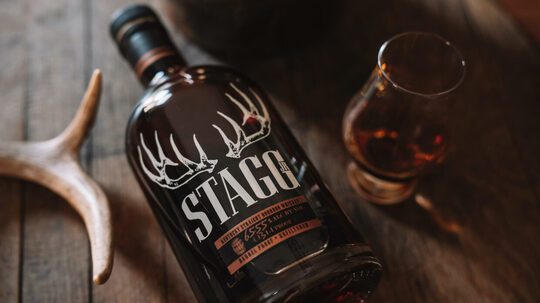
Shopping for scotch doesn't have to feel like defusing a bomb. Whether you're buying for your whisky-obsessed uncle, that colleague who's just discovered single malts, or the friend with a cabinet full of bottles you can't pronounce, this guide has you covered. From budget-friendly gems to bucket-list bottles, here's how to nail scotch gifting this Christmas.
Nick Offerman's fourth collaboration with Lagavulin takes an unexpected turn—Caribbean rum cask finishing on 11-year-old Islay whisky. After aging in ex-bourbon and sherry casks, this spends eight months in rum barrels, adding tropical fruit notes to Lagavulin's signature peat smoke. Drinkhacker scored it an A, proving that sometimes the unexpected combinations work beautifully.
Now here's a scotch only a select few can pronounce properly—if you want to watch your gift recipient stumble over the name for the next five minutes, this is your champion. This travel retail exclusive is an intriguing marriage of Bunnahabhain single malts finished in ex-red wine casks. For someone who wants to explore Islay without getting knocked over by peat smoke, this delivers coastal character with vibrant fruit complexity. It's unpeated Islay done right—even if saying it correctly remains delightfully wrong.
Another travel retail gem worth hunting down. Four different cask types—ex-bourbon barrels, quarter casks, virgin American oak, and European oak hogsheads—create golden, creamy peat smoke with toasted vanilla, sandalwood, and hints of pine. Even the most seasoned scotch drinkers likely haven't tried anything aged in four different cask types, making this an ideal gift when you want to offer something genuinely interesting while staying on a budget.
Probably one of the most iconic scotches of all time, and there's a reason for it. Blue Label is the Disneyland version of Scottish whisky, and that's meant as the highest compliment. It distills the essence of what makes scotch great into one approachable bottle—clean, pristine, and idealized. Selected from only one in 10,000 casks, it works for first-time drinkers and jaded enthusiasts alike.
Created in 1953 to celebrate Queen Elizabeth II's coronation, Royal Salute hasn't changed since—and that's intentional. This 21-year-old blend delivers luscious pears, orange marmalade, and hazelnut cream. The blenders at Chivas Brothers keep the exact composition close to the vest—perhaps channeling the late monarch's discretion in keeping calm and carrying on without oversharing. The sapphire blue ceramic decanter is, in my opinion, one of the most beautifully designed bottles on the market—a work of art that deserves a permanent place on the shelf even after the whisky is gone. Plus, we're offering best-in-market pricing right now.
Springbank remains one of Scotland's most respected distilleries, and this cask strength 12-year-old shows why. Matured in ex-bourbon and sherry casks, then bottled at varying proofs depending on the batch, it delivers caramel, marzipan, honey, smoke, peat, and oak in beautiful harmony. For the person who appreciates craft and authenticity, Springbank does everything on-site from malting to bottling—and you can taste that commitment.
Every Macallan drinker has been waiting for this one—only just released, this is the gift for the Macallan enthusiast in your life. For years, fans faced an impossible choice: age or proof. The new 12 Year Old 110 Proof finally bridges that gap, combining 12-year maturity with bold, concentrated flavors. Matured exclusively in European oak casks seasoned with sherry wine in Jerez, the 110 proof hits that sweet spot where the whisky retains approachability while delivering the concentrated character that makes cask strength expressions so compelling.
This scotch was just named #2 on Whisky Advocate's top whiskies of 2025, receiving 95 points—the highest rated scotch on the list. Released in April 2025, most people haven't even tried this yet. Aged in European and American oak, then finished for more than 4 years in oloroso and palo cortado sherry casks, that extended finishing lends incredible alluring sweetness to the whisky. For someone who thought they knew Oban, this will be a revelation.
Inspired by Ethiopian Arabica coffee beans but without any coffee flavoring added, this is the perfect gift for giving a seasoned scotch drinker something different and experimental. The Harmony Collection lets fans experience Macallan from a different perspective than standard core-range expressions. Matured in ex-bourbon American oak and refill sherry oak at 44% ABV, the highlight is the delicious interplay between bitter and sweet—if your recipient loves both coffee and whisky, this will be right up their alley.
Balvenie finishes this 15-year-old in Pedro Ximénez sherry casks hand-picked from Spain, creating explosive ripe single malt swimming in deep sherry notes. Bottled at 97.4 proof, Drinkhacker calls it "one of my favorite Balvenie releases in recent memory." For someone who's covered the standard age statements and wants to explore interesting cask finishes, this delivers without being too experimental.
We've hand-selected a collection of bottles that would fit seamlessly into any high-end scotch collection. These are investment-worthy expressions on the pricier side, representing the kind of bottles that true connoisseurs dream about. Whether you're celebrating a major milestone or giving an unforgettable gift to someone with discerning taste, these deliver prestige, rarity, and exceptional quality in equal measure.
With only 166 bottles produced from a single cask selected by Malt Master Brian Kinsman, this 39-year-old represents genuine rarity. Distilled in 1977 and bottled at 44.9% ABV, each hand-numbered bottle comes with aged oak, apple, toasted nuts, cream, tannins, and caramel-dipped citrus. For the serious collector who has everything else, this offers something genuinely exceptional and increasingly scarce.
Distilled in 1972 and bottled in 1998, this represents the era collectors obsess over—when Macallan's profile was dramatically different from today. This is full sherry maturation from the golden age, delivering big ripe red fruit, date, prune, dark chocolate, and earthy mineral complexity at 43% ABV. With only one bottle available, this represents old-school Macallan character that's virtually impossible to find today.
Released in 2016 to celebrate Lagavulin's bicentennial in a run of just 8,000 bottles worldwide, this 25-year-old shows what extended aging does to Islay peat. Quarter-century maturation softens the signature smoke into something remarkably elegant—refined coastal character rather than medicinal punch. For the Islay collector, this anniversary release represents distillery history that only gets harder to find.
If there's a bucket-list bottle for any scotch drinker, this is it. Matured exclusively in hand-picked sherry seasoned oak casks from Jerez for a minimum of 30 years, this consistently scores well in international competitions. Honeyed figs, dates, rich fruit cake, prunes, stem ginger, and a long finish with oak, spice, and orange at 43% ABV—this is as prestigious as scotch gets. The price reflects both the age and rarity, but for the centerpiece bottle, nothing matches this.
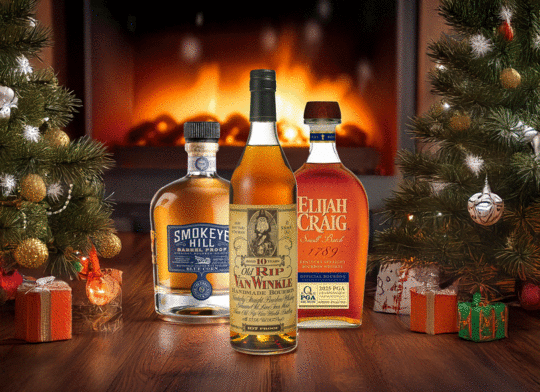
Look, finding the perfect bourbon gift doesn't have to send you spiraling down a Reddit rabbit hole at 2 AM. Whether you're shopping for your boss who "knows whiskey" or your college buddy who's finally graduated from Jack and Coke, we've got you covered.
If you want to give a gift that screams "if you know, you know" or shows genuine good taste, this is the bourbon. Fred Minnick's ASCOT Awards named it Best Bourbon of 2024, beating George T. Stagg and other industry heavyweights. Made from Indiana Heirloom Blue Corn and bottled uncut, unfiltered at around 130 proof in Colorado Springs, this relatively unknown brand is producing exceptional cask-strength bourbon at a remarkable price point of only $89. It's proof that great bourbon doesn't always come from familiar names and is sure to impress any bourbon lover in your life!
Sometimes you just can't go wrong with a classic. Eagle Rare 10 Year is one of the finest bourbons produced by Buffalo Trace—impeccably balanced and remarkably complex. This beautifully refined Kentucky straight bourbon was once a single barrel expression but has adopted a new production method, though it maintains the exceptional flavor that makes it difficult to find on shelves. Given its popularity with bourbon purists and its accessible price point, this is an extremely safe gift that anyone can appreciate and enjoy.
Got a golfer or golf fanatic in your life? This annual commemorative celebrating the PGA Championship is a hole-in-one gift. This 94-proof small batch offers quality and collectibility without the premium price tag—consider it par for the course when it comes to thoughtful bourbon gifts. It's well-crafted whiskey that works both for golf enthusiasts and as an accessible entry into limited editions.
Ask any bourbon drinker about their dream pour, and you'll likely hear the Van Winkle name mentioned. The price tag reflects that prestige—this sits on the heftier side at $799.99 . But here's the thing: it's actually one of the more accessible Van Winkle expressions while maintaining every bit of the family's legendary status. For the bourbon lover who has everything else, this checks a major box. If you really want to spoil the Bourbon lover in your life, this is the bottle to get.
Part of Buffalo Trace's legendary Antique Collection, George T. Stagg is uncut, unfiltered, and regularly clocks in over 140 proof. Because of its cult like following, bourbon fanatics will likely never see this bottle in their local liquor stores and is always sold above MSRP. At least 15 years in the barrel creates intense maple, oak, and caramelized sweetness that can be overwhelming at full strength. Add a few drops of water, though, and this powerhouse opens up beautifully, revealing surprising complexity beneath all that heat. It's bold bourbon at its finest.
These are genuinely rare finds—we only have two in stock. The '90s set includes Austin Nichols Wild Turkey Real Kentucky (43.4%), six Wild Turkey branded glasses, poker chips, and playing cards. The 2000s version comes with similar gear and a different bottle. For Wild Turkey's devoted following, these aren't just quirky collectibles—they're time capsules from an era when distilleries had more fun with their marketing. A super unique gift that any Wild Turkey fan would be lucky to have.
Want to give someone something truly interesting? How about a bourbon that isn't even available in the United States? This bottle carries genuine bourbon history—during the industry's dark ages, Four Roses couldn't sell straight bourbon in America and focused entirely on Asian markets just to survive. Their straight bourbon didn't return stateside until 2002. This Japan-exclusive Super Premium offers a fruitier, more mature profile than Four Roses Small Batch and represents one of the few accessible Japanese exclusives. It's tangible bourbon history most Americans don't even know exists.
With many citing this as bourbon of the year for 2025, it was hard not to include it on this list—especially given its incredibly unique aging process. Bardstown acquired 300-year-old French oak barrels originally harvested for Notre Dame Cathedral's reconstruction. They finished a blend of five premium bourbons (aged 9-18 years) in these historic barrels for 14 months, bottling at 110.1 proof. The result is a genuine contender that's literally history in a bottle.
Everybody has heard of Buffalo Trace bourbon—it's a staple in many collections. However, not many have even heard of or had the chance to try this super limited release. In 1999, warehouse manager Ronnie Eddins traveled to the Ozarks to personally select 96 specific trees for an unprecedented experiment. They separated them by grain type, cut each into sections, seasoned the staves for different periods, then created 192 different single barrels with varying recipes and entry proofs.
Here's the perfect gift for someone who has everything: Prichard's Double Chocolate Bourbon brings together Tennessee whiskey tradition with artisan chocolate from Olive and Sinclair. This unusual bourbon gets double-barrel aged for up to 14 years before being infused with single-origin cacao beans, creating genuine chocolate essence rather than liqueur sweetness at 90 proof- perfect for the holiday season. The Ultimate Spirits Challenge awarded it 90 points for a reason—this actually works.
Here's a bottle most of your bourbon fanatic friends have been keeping their eyes out for in local liquor stores but likely haven't seen yet—it was one of 2025's most hyped releases. Everybody has tried Eagle Rare 10, and everybody's been hunting for this 12-year expression. Buffalo Trace has bridged the gap between the beloved 10-year and coveted 17-year releases with twelve years at 95 proof. Five extra proof points and two additional years create greater structural complexity while maintaining Eagle Rare's approachable character. Gift this and you'll likely hear "I've been wanting to try this" or "Where did you find this?" Get in early before allocation madness takes hold.
December 18, 2024, marked a historic moment when the U.S. Alcohol and Tobacco Trade Bureau officially recognized American Single Malt Whiskey as a distinct category. Jack Daniel's American Single Malt represents the distillery's take on this new category—something unique and interesting for the everyday bourbon drinker to venture into new territory while having that familiar Jack Daniel's label in front of them. Our partners at Breaking Bourbon describe it: "An American single malt that plays it safe yet is able to retain classic Jack Daniel's characteristics."
For collectors who understand bourbon history, A.H. Hirsch represents the ultimate get. Distilled in 1974 at Pennsylvania's now-abandoned Michter's distillery, only 400 barrels were salvaged, yielding just 4,244 cases worldwide. These "rescued" bourbons were bottled at 91.6 proof after 16 years. Whether you find Blue Wax or Gold Foil, you're acquiring increasingly rare liquid history. Warm oak, honeysuckle, caramel, and cinnamon spice define a bourbon that collectors hunt worldwide—and that only becomes scarcer with time.
This discontinued, pre-2016 squat bottling proves a hard truth: bourbon quality has changed. At 90 proof, this wheated bourbon performs well beyond recent Buffalo Trace releases from the last decade. These archive bottles represent an era when production focused more on quality than meeting demand—before the allocation frenzy reshaped the industry. For collectors, these dusty bottles offer tangible proof of bourbon's evolution and serve as benchmarks for what Weller once delivered consistently.
This is probably one of the rarest and most collectible bottles you could ever purchase on the market—and it definitely shows in the price tag. We have only one in stock. At 25 years old, Eagle Rare 25 marks the oldest and rarest expression released from the Eagle Rare portfolio, limited to just 200 bottles worldwide. This groundbreaking 101-proof bourbon, part of Buffalo Trace's $20-million experimental Warehouse P program, is presented in a hand-blown crystal decanter featuring a sterling silver wing and custom glass eagle. For the serious collector who wants something truly exceptional, this is as rare as it gets.
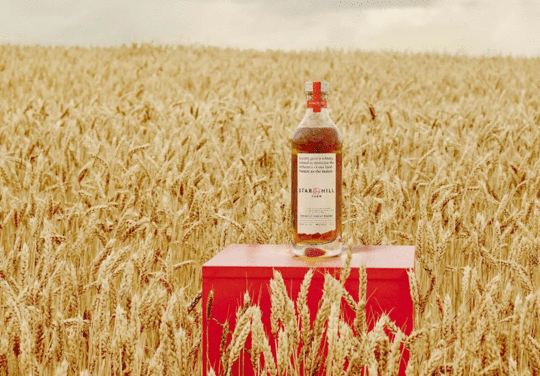
As whiskey consumers increasingly demand transparency and authenticity, estate whiskey has emerged as the answer. This grain-to-glass approach offers complete traceability from farm to bottle, representing both a return to distilling's agricultural roots and a bold statement in today's crowded market.
Estate whiskey means the distillery grows its own grains and handles every production step on-site. The Estate Whiskey Alliance (EWA), formed in 2023, certifies distilleries meeting specific standards: at least two-thirds of grains must come from land the distillery owns or controls, with milling, cooking, fermenting, distilling, barreling, aging, and bottling all happening at one location.
This model transforms distilleries into farmer-distillers—agricultural operations first, spirit producers second. It's a throwback to how American whiskey began, when farmers distilled their own harvests rather than sourcing from commodity suppliers.
Estate distilleries control variables impossible for traditional operations to manage. From soil health and irrigation schedules to grain variety selection and harvest timing, every decision impacts the final whiskey. This creates genuine terroir—spirits that express the characteristics of specific land and climate, much like wine.
The philosophy centers on quality over quantity. Estate operations can prioritize slow grain growth for better flavor development rather than maximizing yield. This attention to agricultural detail carries through to every production stage, resulting in whiskey that couldn't be replicated elsewhere.
The Alliance launched with seven founding members representing both pioneering estate operations and established brands embracing the model: (Saskatchewan, Canada), (Bardstown, Kentucky), (Ancram, New York), (Loretto, Kentucky), (Loretto, Kentucky), (Bardstown, Kentucky), and (Beaver Dam, Kentucky). The Alliance welcomes not just distilleries but also farmers, suppliers, academic institutions, and related organizations committed to advancing estate whiskey production.
Some states have created additional certifications. Nevada's 2019 estate law requires 85% of ingredients from distillery-controlled land. New York's Empire Rye mandate requires 75% New York-grown grain and in-state production for all steps. These regional programs add another layer of geographic authenticity.
in Nevada operates on 2,000 acres, growing all their grains including non-GMO corn, wheat, barley, and rye. Their portfolio includes a five-year straight bourbon, bottled-in-bond rye, and experimental Single Grain releases like 100% Wheat and 100% Oat whiskeys that demonstrate how grain choice shapes character.
in New York pioneered the modern estate distillery concept and helped develop the Empire Rye standards. in Illinois takes a similar farm-first approach with complete production transparency.
Major distilleries are joining the movement too. Heaven Hill, Maker's Mark, and Michter's have all established farming operations, betting that grain quality directly impacts whiskey quality.
Estate whiskey shares DNA with bottled-in-bond but serves a different purpose. The 1897 Bottled-in-Bond Act established consumer protections requiring single-distillery production, minimum four-year aging, and 100 proof bottling—crucial transparency when whiskey adulteration was rampant.
Estate certification adds the agricultural component, requiring distilleries to grow their own grains. Some whiskeys qualify for both designations, offering maximum transparency: verified grain source, single-site production, and federal quality standards.
Estate whiskey appeals to drinkers who value provenance and sustainability. These operations represent a commitment to doing things deliberately rather than efficiently, believing the extra effort produces distinctly better spirits.
The model often proves economically viable despite higher labor requirements. Vertical integration eliminates grain brokers and middlemen, with distilleries capturing value at every production stage. This can translate to competitive pricing despite the premium nature of the product.
As more consumers seek authentic stories and transparent production, estate whiskey's grain-to-glass narrative resonates. The EWA has created infrastructure making certification accessible and educating consumers on what estate designation means.
Whether you're exploring Nevada's grain-forward bourbons, New York's rye whiskeys, or limited estate releases from established brands, you're tasting something fundamentally different—spirits shaped by specific land, grown and distilled by people who control the entire journey from seed to sip. That's estate whiskey: farming and distilling united, proving that great whiskey truly begins in the soil.
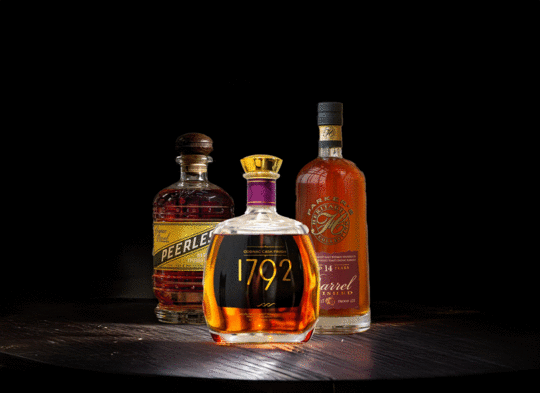
When mature whisky meets a used cognac cask, magic can happen—but only when done right. The French, who are the the sole producers of cognac, understand this balance better than anyone. Cognac-finished whiskies are emerging as some of the most opulent and complex expressions on the market, delivering a unique flavor profile that's captivating enthusiasts worldwide.
By law, cognac casks are crafted exclusively from French oak sourced from the legendary forests of Tronçais and Limousin—considered among the highest quality wood for casks in the world. These aren't just any barrels; they're vessels that have held exceptionally old cognac, often for 30 years or more, concentrating aromatic compounds that add extraordinary depth to whisky.
Patrick Léger, both cellar master for Camus cognac and master blender for Lambay Irish Whiskey, explains the appeal: "Camus is particularly rich in esters, which increases the complexity and aromatic richness of our finish." The key is patience—allowing the whisky to slowly absorb the cognac's lingering flavors without overwhelming the spirit's core character.
What can you expect from cognac-finished whisky? Think beyond typical sherry or bourbon cask notes. Cognac finishing brings:
As Sandy Hyslop, Director of Blending for Chivas Brothers, notes: "The cognac cask finish brings an unexpected—often fruity—flavor dimension to our whiskies. The real secret lies in managing the fine balance between the distillery's unique flavors and the cask influence—and in allowing both to shine."
With cognac consumption on the rise, more high-quality casks are becoming available to whisky makers. Major spirits companies like LVMH (Hennessy, Glenmorangie, Ardbeg), Beam Suntory (Courvoisier, Jim Beam, Laphroaig), and Rémy Cointreau (Rémy Martin, Bruichladdich) are perfectly positioned to explore these synergies, producing both cognac and whisky under the same roof.
Recent releases pushing the cognac cask envelope include Crown Royal XO, Lambay Single Malt and Small Batch Irish Whiskies (both finished in Camus casks), Belle Meade XO Cognac Cask-Finished Bourbon, and Scotch expressions like Glenlivet Captain's Reserve and Chivas Regal XV. Even American bourbons like Jim Beam 18 Year Distillers' Masterpiece and Parker's Heritage Collection have explored cognac finishing with impressive results.
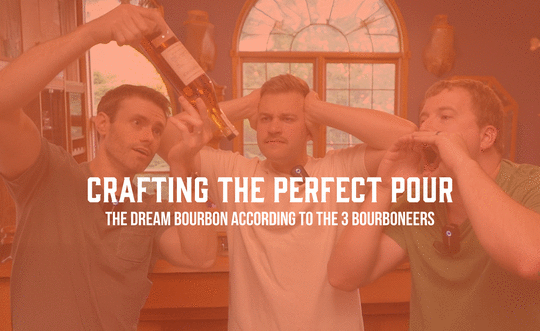
Hey there, whiskey friends. We’re The 3 Bourboneers - just three thirty-something buddies from western Wisconsin with a shared love for great bourbon, questionable hunting stories, and long nights around the fire pit.
Over the years (and many bottles), we’ve had plenty of late-night debates about what makes the perfect bourbon. Is it the proof? The age? The char? The bottle that looks cool on the shelf when your buddies come over for poker night?
Eventually, we decided to put pen to paper and dream it out. So here it is - if we had our pick of the barrel, this is how The 3 Bourboneers would craft our perfect bourbon.
We’ve tasted enough bourbon to know that 12 years is where the magic happens. Not too young, not over-oaked - it’s the sweet spot. After 12 full years in the barrel, you get those rich vanillas, deep caramels, a little tobacco, and all that oaky goodness without it tasting like you’re chewing on a stave. Anything younger feels like it's still figuring itself out. Anything older can get too woody. For us Bourboneers, 12 is the Goldilocks zone.
We’re big fans of a pour with some kick - but not something that singes your eyebrows. 110 proof is where we land every time. It's got enough heat to keep things interesting, but still smooth enough to sip neat after a long day splitting wood or shoveling snow. We’ve found that 100-120 proof bourbons are what we call “crushable” - full of flavor, just the right amount of burn, and always worth a second pour.
Flavor-wise, we tend to gravitate toward what Jim Beam and Heaven Hill are putting out (although Michter’s is in the running lately). There's something about that sweet nuttiness from Beam mixed with the spicy rye-forward kick of Heaven Hill that just hits right. If we were designing a mashbill, it’d blend the best of both worlds. Something corn-heavy with a decent rye backbone and just enough malt to smooth it out. A true Wisconsin blend if there ever was one - traditional, bold, and just a little spicy.
We’re not here for subtle flavors. We want richness. We want depth. We want the bourbon equivalent of a smoked brisket that’s been on the pit for 18 hours. That’s why we’re going with a Level 4 “alligator” char. It brings out all those rich, dark sugars from the oak and layers in that toasted caramel, chocolate, and spice that keeps you coming back. It’s the deep-end of the flavor pool - and that’s where we like to swim.
Look, we love Wisconsin - but when it comes to bourbon, Kentucky is king. They’ve got the limestone water, the seasons, and the history. But more importantly, they’ve got the rickhouses.
If we had our way, we’d age our barrels high up in a Kentucky rickhouse, where the temps swing big and the barrels sweat hard. The more heat and interaction with the oak, the more concentrated the flavor. We’re talking full-send aging.
If you’re going to make a bourbon you’re proud of, you’ve got to dress it up right. We’d go with a tall, elegant wine-style bottle, something along the lines of Eagle Rare or Colonel Taylor.
There’s just something about a bottle that stands taller than the rest on the shelf. It says, “Hey, I’m special,” without yelling it. Plus, it just looks better when you gift it, or pull it out at deer camp to show off a little.
Will we ever actually distill our own bourbon? Who knows. We’re just three guys from Wisconsin who love a good pour and a better conversation. But if we ever do, this is what we’d make - something that reflects who we are: bold, balanced, and built to be shared.
Until then, we’ll keep sampling, sipping, and dreaming - and bringing you along for the ride.
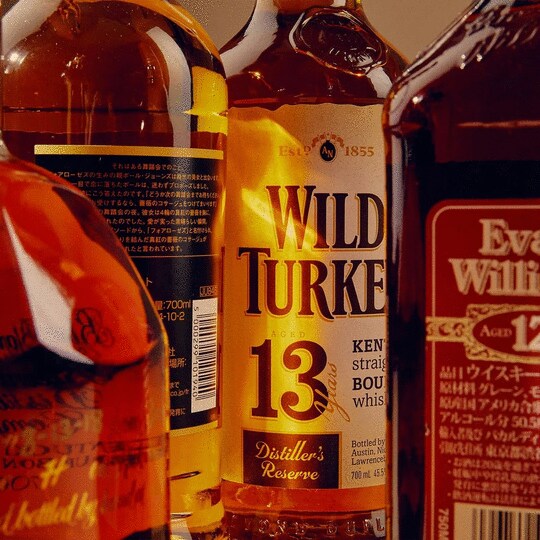
When American bourbon was struggling to find buyers in the 1970s and 80s, Japan became its unlikely savior. Japanese consumers, raised on aged Scotch whisky, demanded older, more premium bourbon than Americans were drinking. The result? Some of America's finest distilleries created exclusive, ultra-aged expressions solely for the Japanese market—bottles that remain virtually impossible to find stateside.
Today, these Japan-exclusive bourbons represent some of the most sought-after whiskey in the world. Here are the legendary bottles that bourbon hunters dream of finding.
The most famous Japan-exclusive bourbon story belongs to Blanton's. When Japanese company Takara Shuzo gained control of Age International in 1991, they created three distinct expressions that have become the stuff of legend.
The crown jewel of the Takara line, aged for a minimum of 8 years (two years longer than standard Gold) and bottled at 51.5% ABV. Using Buffalo Trace's #2 mash bill with an estimated 12-15% rye, this is one of the rarest and most sought-after whiskeys in circulation.
The original Japan-exclusive Blanton's, also aged approximately 2 years longer than its American counterpart, making it roughly an 8-year bourbon instead of 6.
The mildest of the Takara trio, bottled at 80 proof and aged for 8 years, this was crafted specifically for Japanese palates accustomed to lower-proof spirits.
Jimmy Russell's legacy in Japan runs deep, with multiple exclusive releases:
A revival of an old Wild Turkey expression with new specs for 2022. This 12-year-old bourbon uses Wild Turkey's traditional 75% corn, 13% rye, 12% malted barley mashbill and maintains the classic 101 proof. Found in Tokyo stores for around $45, it represents exceptional value for a well-aged Wild Turkey expression that simply doesn't exist in the American market.
The successor to the beloved 12-year Japan exclusive (now discontinued). While it lacks the 101-proof punch of its predecessor, it offers exceptional drinkability with more mature flavors.
To commemorate Jimmy Russell's 50th anniversary with Wild Turkey in 2004, Russell personally selected barrels from the company's very best stock. While 5,500 bottles were released domestically at 101 proof in short bottles with gold medallions, 9,000 bottles were created exclusively for Japanese export at 110 proof in the distinctive "tail feather" style bottle with brown box packaging—making the Japanese version both more potent and more numerous than its American counterpart.
Four Roses' survival story is tied directly to Japan. When the company couldn't sell straight bourbon in America, they focused on Asian markets—their straight bourbon didn't return to the U.S. until 2002. The Super Premium, available in nearly every Japanese liquor store for about $50, offers a fruitier, more mature profile than Four Roses Small Batch and represents one of the most accessible Japan exclusives.
Released in February 2002 by Kirin Brewery Company of Japan, Four Roses Black Label is an exclusive bourbon available only to the Japanese market. This carefully crafted blend uses two separate mash bills aged up to 10 years, creating a complex flavor profile with delicate notes of caramel and spice. The extended aging and precise blending make this an elegant and exceptional spirit that showcases Four Roses' mastery in creating Japan-specific expressions.
While technically available at the Louisville distillery gift shop, this 101-proof expression is readily found in Japan at a much cheaper price point. With its robust maraschino cherry and dark chocolate profile, it's what reviewers call "a supremely well-executed bourbon" and "highly overqualified daily drinker."
While you can technically find this at the Evan Williams Experience in Louisville, it was primarily created for Japanese export. This 107-proof giant showcases what happens when Heaven Hill's bourbon gets serious age—dark chocolate, leather, molasses, and polished wood create a complexity that's both refined and powerful. Reviewers consistently rate it 8.5/10 or higher, praising its perfect balance of age and complexity without being over-oaked.
Perhaps the most mysterious entries in the Van Winkle pantheon are the Family Reserve 16 and 17-year-old vintage bottlings, exclusively exported to Japan in 1990 and 1991. These bottles, purportedly containing whiskey from the Boone distillery, represent Julian Van Winkle III's prescient understanding of international markets at a time when American bourbon was struggling domestically.
Sourced from 1974 barrels and bottled during the Old Commonwealth era, these expressions offer collectors a unique glimpse into Van Winkle's evolution from struggling brand to global phenomenon. The Japanese market's willingness to pay premium prices for well-aged bourbon provided crucial revenue during bourbon's wilderness years.
Although many variants were released under the Hirsch label—15, 16, 17, 18, 19 and 20-year-olds—the 15-year gold wax "script" variant is sought after because of its Lawrenceburg bottling location, Japanese export status and overall rarity. The Hirsch distillate was copper pot distilled in 1974 by Pennco and is believed to have yielded a 400-barrel batch, making each surviving bottle extraordinarily precious.
Perhaps no bottle better represents the "glut era" than Bourbon Valley 24-Year. When Heaven Hill found itself with excess mature whiskey in the 1990s, they created this masterpiece exclusively for Japan. Barreled in December 1974 and bottled in 1999, this pre-fire Heaven Hill bourbon features the distinctive dripping black wax seal that adds to its mystique and collectibility.
What makes it special: Distilled at the original Heaven Hill distillery before the devastating 1996 fire, making it one of the most treasured pre-fire expressions with a double-digit age statement.
These Japan-exclusive bottles did more than just provide sales for struggling distilleries—they fundamentally changed bourbon. Japanese demand for aged, premium expressions helped establish the template for today's allocated bourbon market. When Americans rediscovered bourbon in the 2000s, distilleries already had the knowledge and infrastructure to produce the high-end, age-stated products that modern consumers crave.
Today, Japan remains what author Aaron Goldfarb calls "a dusty bourbon haven." Unlike American stores picked clean by collectors, Japan's massive cache of premium bourbon from the 1970s-90s remains relatively intact. For the dedicated bourbon hunter, Japan represents the ultimate treasure hunt—shelves potentially hiding bottles that would cost thousands in America, if they could be found at all.
These Japanese exclusives aren't just rare bottles—they're liquid history, representing a time when Japan appreciated American bourbon more than America itself. Each bottle tells the story of cultural exchange, business necessity, and the Japanese palate that helped save American whiskey during its darkest hour.
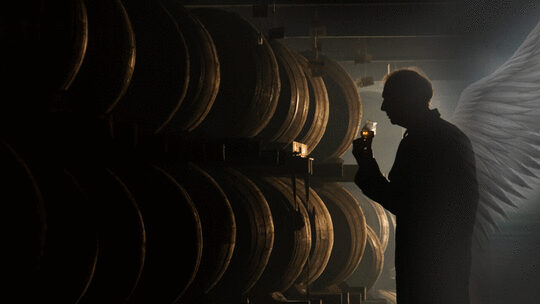
There's something almost mystical about stepping into a whiskey warehouse. The air is thick with the sweet, woody aroma of aging spirits, and if you know what you're experiencing, you're literally breathing in what distillers have called the "Angel's Share" for centuries.
The Angel's Share is the portion of spirit that evaporates during the aging process—essentially the liquid that disappears into thin air while your whiskey, bourbon, or cognac sits patiently in its barrel. Medieval Irish and Scottish distillers, with their poetic sensibilities, believed this vanishing alcohol was claimed by benevolent angels as their rightful tribute.
While the folklore is charming, the science is straightforward: wooden barrels breathe. As temperatures fluctuate throughout the seasons, the wood expands and contracts, allowing some of the precious liquid inside to escape as vapor. It's this natural evaporation that perfumes distillery warehouses with that intoxicating boozy sweetness.
Here's where it gets expensive. In Scotland's cool climate, distillers typically lose about 2% of their barrel's contents each year to the Angel's Share. That might not sound like much, but consider that Scotch whisky must age for a minimum of three years—meaning at least 6% vanishes before the first bottle is ever filled.
Move to warmer climates like Kentucky or Texas, and those numbers jump dramatically. American distillers can lose 4-6% annually, with some particularly hot locations seeing rates as high as 12% per year. This is why a 25-year-old Scotch might have lost half its original volume to the angels, making each remaining drop exponentially more valuable.
But here's the beautiful irony: what seems like pure loss is actually essential to creating exceptional spirits. As alcohol evaporates, the remaining liquid becomes more concentrated and complex. The interaction between the spirit and the wood intensifies, drawing out vanilla, caramel, and spice notes that define aged spirits.
Think of it as nature's own quality control system. The Angel's Share doesn't just reduce quantity—it enhances what remains, creating the smooth, nuanced flavors that make aged spirits so coveted.
Want to see the Angel's Share in dramatic action? Look no further than Buffalo Trace's Eagle Rare 17 Year releases. The 2024 bottling experienced an extraordinary 86% evaporation loss during its aging process—meaning that of all the barrels selected for this bottling, only 14% of the original liquid remained.
To put that in perspective: if you started with 100 barrels of new-make bourbon, you'd end up with just 14 barrels' worth of liquid after the angels claimed their generous share. It's the second-highest evaporation rate ever recorded for Eagle Rare 17. But here's the thing about the Angel's Share—extreme evaporation doesn't automatically guarantee exceptional quality. The 2013 Eagle Rare 17, despite its own significant 54.7% evaporation loss, didn't translate that concentration into a standout final product, proving that the magic happens when high concentration meets perfect barrel selection and optimal aging conditions.
This evaporation is a major reason why aged spirits command premium prices. When a distiller fills a barrel with new-make spirit, they're essentially betting on the future, knowing that time will claim its share. More barrels must be filled to account for the inevitable loss, storage costs accumulate over years or decades, and the risk increases with every passing season.
When you're sipping that perfectly aged bourbon or single malt, you're not just tasting the distiller's craft—you're experiencing the concentrated essence of what the angels left behind. It's a reminder that in the world of fine spirits, patience truly is a virtue, and sometimes the most valuable things are worth the wait.
